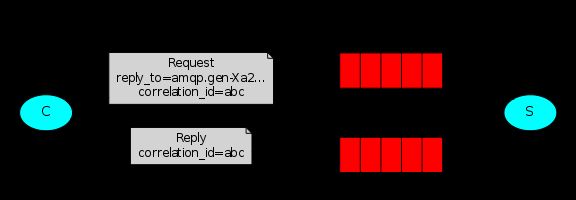目录
RabbitMQ学习总结 第一篇:理论篇
RabbitMQ学习总结 第二篇:快速入门HelloWorld
RabbitMQ学习总结 第三篇:工作队列Work Queue
RabbitMQ学习总结 第四篇:发布/订阅 Publish/Subscribe
RabbitMQ学习总结 第五篇:路由Routing
RabbitMQ学习总结 第六篇:Topic类型的exchange
RabbitMQ学习总结 第七篇:RCP(远程过程调用协议)
在http://www.cnblogs.com/leocook/p/mq_rabbitmq_2.html 这篇博文中我们实现了怎么去使用work queue来把比较耗时的任务分散给多个worker。
但是,如果我们想在远程的机器上的一个函数并等待它返回结果,我们应该怎么办呢?这就是另外一种模式了,它被称为RPC(Remote procedure call)。
本篇博文中我们来实现怎么用RabbitMQ来构建一个RPC系统:一个client(客户端)和一个可扩展的RPC server(服务端)。这里我们来模拟一个返回斐波拉契数的RPC服务。
1、Client端接口
为了说明一个RPC服务时怎么工作的,我们来创建一个简单的client类。这里来实现一个名字为call的方法来发送RPC请求,并发生阻塞,直到接收到回复:
FibonacciRpcClient fibonacciRpc = new FibonacciRpcClient(); String result = fibonacciRpc.call("4"); System.out.println( "fib(4) is " + result);
RPC注意事项:
虽然RPC是一种常用的模式,但它也有一些缺陷。当无法确定使用本地调用还是使用RPC时,问题就出来了。有的时候不确定程序的运行环境,这样来做会给程序的调试增加了一定的复杂度。使用RPC并不能够让代码变得更简洁,滥用的话只会让代码变得更不方便维护。
伴随着上边的问题,咱们来看看下边的建议:
- 确定能很明显的分辨的出哪些调用是本地调用,哪些是远程调用。
- 完善系统的文档。清楚的标记出,模块间的依赖关系。
- 处理错误情况。当RPC服务挂了之后,客户端应该怎么去处理呢?
当有疑问时避免使用RPC。如果可以的话,你可以使用异步管道(不用RPC-阻塞),结果被异步推送到下一个计算环节。
2、回调队列(Callback queue)
一般用RabbitMQ来实现RPC是很简单的。客户端发送一个请求消息然后服务器端回应一个响应消息。为了接收服务端的响应消息,我们需要在请求中发送一个callback queue地址。我们也可以使用一个默认的queue(Java客户端独有的)。如下:
callbackQueueName = channel.queueDeclare().getQueue(); //绑定callback queue BasicProperties props = new BasicProperties.Builder().replyTo(callbackQueueName).build(); channel.basicPublish("", "rpc_queue", props, message.getBytes()); // ... then code to read a response message from the callback_queue ...
消息属性:
AMQP协议在发送消息时,预定义了14个属性连同消息一起发送出去。很多属性都是很少用到的,除了下边的这些:
消息的投递模型(deliveryMode):使消息持久化,和work queue里的设置一样。
上下文类型(contentType):用来描述媒体类型(mime-type)。例如常用的JSON格式,它的mime-type是application/json。
我们需要导包:
import com.rabbitmq.client.AMQP.BasicProperties;
3、Correlation Id
在上边的方法中建议我们为每个RPC请求都创建一个call queue,这样效率很低。我们有更好的办法,为每一个client创建一个call queue。
这样处理的话又出现了一个新的问题,无法确定接收到的响应是对应哪个请求的。这时候就需要correlationId属性,我们为每一个请求都设置一个correlationId属性。当我们从callback queue中接收到一条消息之后,我们将会查看correlationId属性,这样就可以用一个请求来与之匹配了。如果从callback queue接收到了一条消息后,发现其中的correlationId未能找到与之匹配的请求,那么将把这条消息丢掉。
你可能会问我们为什么要要在callback queue里忽略掉不知道的message,而不是报错呢?这是因为服务器端可能会出现的一种情况,虽然可能性很小,但还是有可能性的,有可能在RPC发送了响应之后,在发送确认完成任务的信息之前服务器重启了。如果这种情况发生了的话,重启了RPC服务之后,它将会再次接收到之前的请求,这样的话client将会重复处理响应,RPC服务应该是等幂的。
4、总结
我们的RPC工作原理如下:
- 当Client启动时,它将会创建一个匿名的callback queue。
- 对于一次RPC请求,client会发送一条含有两个属性的消息:replyTo和correlationId。Reply是设置的callback queue,correlationId是设置的当前请求的标示符。
- 请求将会被发送到rpc_queue里。
- RPC的worker(RPC server)等待queue中的请求。当出现一个请求之后,他将会处理任务,并向replyTo队列中发送消息。
- 客户端会等待callback queue上的消息。当消息出现时,它将会检查correlationId属性是否能与之前发送请求时的属性一直,若一致的话,client将会处理回复的消息。
5、最终实现
斐波拉契任务:
private static int fib(int n) throws Exception { if (n == 0) return 0; if (n == 1) return 1; return fib(n-1) + fib(n-2); }
这里定义计算斐波拉契数的方法,假设传进去的整数都是正整数。
RPC服务端的代码实现如下RPCServer.java:
import com.rabbitmq.client.ConnectionFactory; import com.rabbitmq.client.Connection; import com.rabbitmq.client.Channel; import com.rabbitmq.client.QueueingConsumer; import com.rabbitmq.client.AMQP.BasicProperties; public class RPCServer { private static final String RPC_QUEUE_NAME = "rpc_queue"; private static int fib(int n) { if (n ==0) return 0; if (n == 1) return 1; return fib(n-1) + fib(n-2); } public static void main(String[] argv) { Connection connection = null; Channel channel = null; try { ConnectionFactory factory = new ConnectionFactory(); factory.setHost("localhost"); connection = factory.newConnection(); channel = connection.createChannel(); channel.queueDeclare(RPC_QUEUE_NAME, false, false, false, null); //一次只接收一条消息 channel.basicQos(1); QueueingConsumer consumer = new QueueingConsumer(channel); //开启消息应答机制 channel.basicConsume(RPC_QUEUE_NAME, false, consumer); System.out.println(" [x] Awaiting RPC requests"); while (true) { String response = null; QueueingConsumer.Delivery delivery = consumer.nextDelivery(); //拿到correlationId属性 BasicProperties props = delivery.getProperties(); BasicProperties replyProps = new BasicProperties .Builder() .correlationId(props.getCorrelationId()) .build(); try { String message = new String(delivery.getBody(),"UTF-8"); int n = Integer.parseInt(message); System.out.println(" [.] fib(" + message + ")"); response = "" + fib(n); } catch (Exception e){ System.out.println(" [.] " + e.toString()); response = ""; } finally { //拿到replyQueue,并绑定为routing key,发送消息 channel.basicPublish( "", props.getReplyTo(), replyProps, response.getBytes("UTF-8")); //返回消息确认信息 channel.basicAck(delivery.getEnvelope().getDeliveryTag(), false); } } } catch (Exception e) { e.printStackTrace(); } finally { if (connection != null) { try { connection.close(); } catch (Exception ignore) {} } } } }
服务器端代码实现很简单的:
- 建立连接,信道,声明队列
- 为了能把任务压力平均的分配到各个worker上,我们在方法channel.basicQos里设置prefetchCount的值。
- 我们使用basicConsume来接收消息,并等待任务处理,然后发送响应。
RPC客户端代码实现RPCClient.java:
import com.rabbitmq.client.ConnectionFactory; import com.rabbitmq.client.Connection; import com.rabbitmq.client.Channel; import com.rabbitmq.client.QueueingConsumer; import com.rabbitmq.client.AMQP.BasicProperties; import java.util.UUID; public class RPCClient { private Connection connection; private Channel channel; private String requestQueueName = "rpc_queue"; private String replyQueueName; private QueueingConsumer consumer; public RPCClient() throws Exception { ConnectionFactory factory = new ConnectionFactory(); factory.setHost("localhost"); connection = factory.newConnection(); channel = connection.createChannel(); //拿到一个匿名(并非真的匿名,拿到了一个随机生成的队列名)的队列,作为replyQueue。 replyQueueName = channel.queueDeclare().getQueue(); consumer = new QueueingConsumer(channel); channel.basicConsume(replyQueueName, true, consumer); } public String call(String message) throws Exception { String response = null; String corrId = UUID.randomUUID().toString();//拿到一个UUID //封装correlationId和replyQueue属性 BasicProperties props = new BasicProperties .Builder() .correlationId(corrId) .replyTo(replyQueueName) .build(); //推消息,并加上之前封装好的属性 channel.basicPublish("", requestQueueName, props, message.getBytes()); while (true) { QueueingConsumer.Delivery delivery = consumer.nextDelivery(); //检验correlationId是否匹配,确定是不是这次的请求 if (delivery.getProperties().getCorrelationId().equals(corrId)) { response = new String(delivery.getBody(),"UTF-8"); break; } } return response; } public void close() throws Exception { connection.close(); } public static void main(String[] argv) { RPCClient fibonacciRpc = null; String response = null; try { fibonacciRpc = new RPCClient(); System.out.println(" [x] Requesting fib(30)"); response = fibonacciRpc.call("30"); System.out.println(" [.] Got '" + response + "'"); } catch (Exception e) { e.printStackTrace(); } finally { if (fibonacciRpc!= null) { try { fibonacciRpc.close(); } catch (Exception ignore) {} } } } }
参考链接:http://www.rabbitmq.com/tutorials/tutorial-six-java.html
